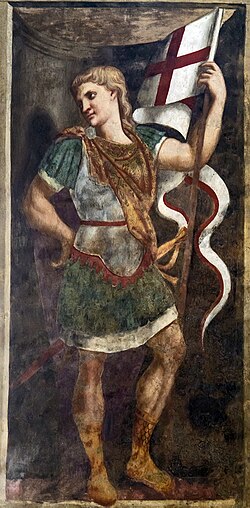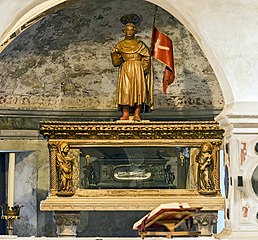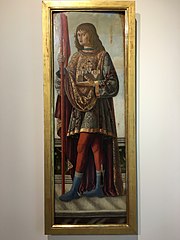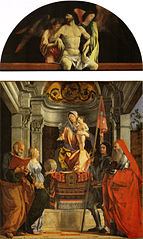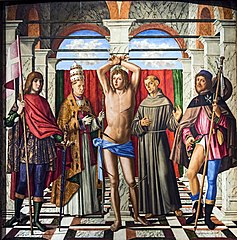
Saint Valentine was a 3rd-century Roman saint, commemorated in Western Christianity on February 14 and in Eastern Orthodoxy on July 6. From the High Middle Ages, his feast day has been associated with a tradition of courtly love. He is also a patron saint of Terni, epilepsy and beekeepers. Saint Valentine was a clergyman – either a priest or a bishop – in the Roman Empire who ministered to persecuted Christians. He was martyred and his body buried on the Via Flaminia on February 14, which has been observed as the Feast of Saint Valentine since at least the eighth century.

Torcello is a sparsely populated island at the northern end of the Venetian Lagoon, in north-eastern Italy. It was first settled in 452 AD and has been referred to as the parent island from which Venice was populated. It was a town with a cathedral and bishops before St Mark's Basilica was built.

July 2 - Eastern Orthodox Church calendar - July 4
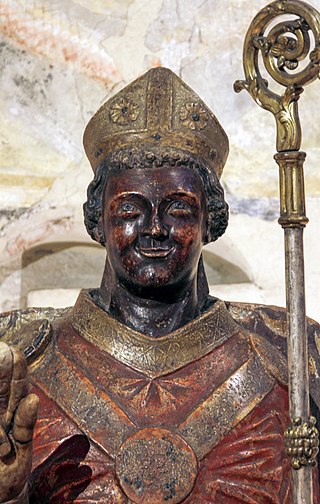
Zeno of Verona was an Afro-Italian Christian figure believed to have either served as Bishop of Verona or died as a martyr. He is venerated as a saint in the Catholic Church and the Orthodox Church.

Altinum was an ancient town of the Veneti 15 km southeast of modern Treviso, close to the mainland shore of the Lagoon of Venice. It was also close to the mouths of the rivers Dese, Zero and Sile. A flourishing port and trading centre during the Roman period, it was destroyed by Attila the Hun in 452. The town recovered, but was later abandoned when sea-borne sand began to cover it over. Its inhabitants moved to Torcello and other islands of the northern part of the lagoon.
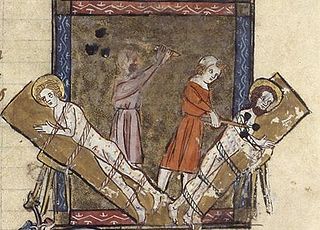
Gervasius and Protasius are venerated as Christian martyrs, probably of the 2nd century. They are the patron saints of Milan and of haymakers and are invoked for the discovery of thieves. Their feast day in the Latin Rite of the Catholic Church is 19 June, the day marking the translation of their relics. In the Eastern Orthodox Church and in the Eastern Rites of the Catholic Church, their feast takes place on 14 October (O.S.)/24 October (N.S.), the traditional day of their death. In Christian iconography their emblems are the scourge, the club and the sword.
Alban of Mainz was a Catholic priest, missionary, and martyr in the Late Roman Empire. He is venerated as Saint Alban of Mainz in the Catholic Church, not to be confused with Saint Alban of Verulamium.
Himeriusof Cremona, also known as Himerius of Amelia or Irnerius, was an Italian bishop. He is venerated as a saint by the Roman Catholic Church and Christian communities of Western Rite Orthodoxy.

The Church of Santa Maria Assunta is a basilica church on the island of Torcello, Venice, northern Italy. It is a notable example of Late Paleochristian architecture, one of the most ancient religious edifices in the Veneto, and containing the earliest mosaics in the area of Venice.

Saint Severus was a bishop of Naples during the 4th and 5th centuries. He is considered the eleventh legitimate Catholic bishop of Naples, and the twelfth overall, succeeding Maximus. His episcopate ran from February 363 to April 29, 409, the traditional date of his death. Between the episcopates of Maximus and Severus, Zosimus, an Arian was established as Bishop, who was condemned as heretical by the Catholic Church.

Heliodorus was the first bishop of Altinum in the 4th century. He was born in Dalmatia. Like Chromatius, he was a disciple of Valerianus, the bishop of Aquileia.
Theonistus is a saint venerated by the Catholic Church. Theonistus is venerated with two companions, Tabra and Tabratha. Medieval documents give accounts of his life, which are contradictory and confusing.
Theonestus of Vercelli is venerated as a martyr and saint by the Catholic Church. Theonestus may have been a member of the early Christian community in Vercelli, living in an era earlier than that of Eusebius of Vercelli. Theonestus may have been a martyr, whose relics were buried in the cemetery where other Christians were buried, outside the city walls. It is believed that his whole body was conserved in the tomb dedicated to him. He is probably not the saint of the same name who was said to have been killed at Altinum by the Arians. This saint of Altinum, whose legend, in any case, is confused and contradictory, may have been confused for the martyr of Vercelli, whose historicity is more certain.

Eleutherius, also written as Eleutherus, Eleuterus and Eleftherios; sometimes called Liberalis or Liberator Greek: Ἐλευθέριος) and his mother Antia, or Anthia are venerated as Christian saints and martyrs in Greece and Italy.

Vigilius of Trent is venerated as the patron saint and bishop of Trent. He should not be confused with the pope of the same name.

Gaudentius of Rimini was a bishop of Rimini, who is venerated as a martyred saint in the Catholic Church and Eastern Orthodox Church.

December 6 - Eastern Orthodox liturgical calendar - December 8

December 13 – Eastern Orthodox liturgical calendar – December 15

Justus of Lyon was the 13th Bishop of Lyon. He succeeded Verissimus in the mid-4th century. He is venerated as a saint by both the Catholic and the Orthodox Church, with a feast day on 2 September. Around 350, Justus was made Bishop of Lyon. As bishop of the capital of Gaul, he was among the participants of the Council of Valence of 374 regarding religious discipline of the clergy and the faithful. He later became a hermit.
